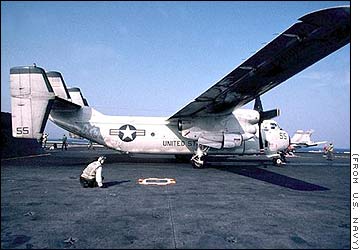
C-2 Greyhounds
Primary function: Carrier-on-board delivery (COD) aircraft
Cruising Speed: 345 mph maximum
Armament: none
Crew: Four
C-2 Greyhounds C-17 Globemaster C-130 Hercules C-141 Starlifter
|
|
C-2 Greyhounds
Primary function: Carrier-on-board delivery (COD) aircraft Cruising Speed: 345 mph maximum Armament: none Crew: Four |
|
|
C-17 Globemaster III Transport
Primary Function: Cargo and troop transport Max payload: 172,200 pounds Speed: up to 518 mph Entered service: 1993 Crew: three |
|
This workhorse provides vital logistical support. It costs $22.9 million, and can take off and fly at 33,000 feet with a 100,000-lb. payload of supplies or 92 troops, 64 paratroops, or 74 patients on stretchers. It has a top speed of 374 mph.
Flight Test with AAR-44 ECM Video
|
C-130 Hercules Transport
Primary Function: Tactical and intratheater airlift, Most widely flown military transport Crew: C-130E/H: Five (two pilots, navigator, flight engineer and loadmaster) Crew: C-130J/J-30: Three (two pilots and loadmaster) Speed: C-130E: 345 mph Power Plant: C-130E: Four Allison T56-A-7 turboprops; 4,200 prop shaft horsepower C-130H: Four Allison T56-A-15 turboprops; 4,591prop shaft horsepower C-130J: Four Rolls-Royce AE 2100D3 turboprops; 4,591 horsepower Length: C-130E/H/J: 97 feet, 9 inches Length: C-130J-30: 112 feet, 9 inches Height: 38 feet, 3 inches (11.4 meters) Wingspan: 132 feet, 7 inches (39.7 meters) Cargo Compartment: C-130E/H/J: length, 40 feet; width, 119 inches; height, 9 feet. Rear ramp: length, 123 inches; width, 119 inches Cargo Compartment: C-130J-30: length, 55 feet; width, 119 inches; height, 9 feet. Rear ramp: length, 123 inches; width, 119 inches Maximum Takeoff Weight: C-130E/H/J: 155,000 pounds, C-130J-30: 164,000 pounds Maximum Allowable Payload: C-130E, 45,050 pounds C-130H, 43,550 pounds; C-130J, 46,631 pounds; C-130J-30, 46,812 pounds Maximum Normal Payload: C-130E, 36,720 pounds; C-130H, 35,220 pounds; C-130J, 38,301 pounds; C-130J-30, 38,812 pounds Range at Maximum Normal Payload: C-130E, 1,838 miles ; C-130H, 2,006 miles; C-130J, 2,729 miles; C-130J-30, 2,897 miles Range with 35,000 pounds of Payload: C-130E, 1,968 miles; C-130H, 2,023 miles; C-130J, 3,062 miles; C-130J-30, 3,269 miles Maximum Load: C-130E/H/J: 6 pallets or 74 litters or 16 CDS bundles or 92 combat troops or 64 paratroopers, or a combination of any of these up to the cargo compartment capacity or maximum allowable weight. C-130J-30: 8 pallets or 97 litters or 24 CDS bundles or 128 combat troops or 92 paratroopers, or a combination of any of these up to the cargo compartment capacity or maximum allowable weight. Ceiling: 33,000 feet with 45,000 pounds Contractor: Lockheed Martin Aeronautics Company Unit Cost: $22.9 million depending on setup and model Date Deployed: C-130A, Dec 1956; C-130B, May 1959; C-130E, Aug 1962; C-130H, Jun 1974; C-130J, Feb 1999 Inventory: Active force, 186; Air National Guard, 217; Air Force Reserve, 107 |
http://www.af.mil/news/factsheets/C_130_Hercules.html
http://www.fas.org/man/dod-101/sys/ac/c-130.htm
http://www.theaviationzone.com/facts/c130.htm
http://users.chariot.net.au/~theburfs/hercMAIN.html
|
C-141 Starlifter
Primary Function: strategic airlift aircraft Max payload: 46,000 - 76,000 lbs Crew: Aircraft Basic Weight: 150,000 pounds Max Takeoff Weight: 323,000 pounds Max Fuel: 153,000 pounds, Fuel Burn per Hour: 12,000 pounds Planned Aircraft Cargo Load (ACL): 46,000 pounds (35,000 mile leg)
Mfg: Lockheed Entered service: 1965 |
The C-141B Starlifter is a strategic airlift aircraft built by the Lockheed Aircraft Corporation with the primary mission of supporting global military activities with airland and airdrop missions. This aircraft is not normally used for intra-theater airlift except in the airdrop role. It will deliver cargo and combat troops from the United States to major airfields within any area of operations. The C-141B provides increased distance, speed, and payload capabilities over the C-130. It is also capable of refueling to greatly extend its range
The C-141 Starlifter was the first pure jet designed for cargo, and it's been a mainstay of U.S. military airlift since 1965. In 30 different configurations, it has seen, done and carried it all - troops, supplies, vehicles, weapons, refugees, disaster relief, even a huge high-powered NASA telescope - from the Persian Gulf to South America to Southeast Asia.
Its easy-to-load 93-foot-long cargo bay can take up to 208 ground troops or 168 paratroops, and it can quickly be converted for med-evac operations. In 1983, after the bombing of the U.S. Marine barracks in Beirut, it was a C-141 that evacuated 78 wounded. Starlifters also brought flood relief to Minnesota in '79, to the Azores in '80, to Louisiana in '83. And when an airliner was hijacked in 1985, a C-141 carried the 39 hostages to freedom. In Desert Storm, C-141s flew more than 37,000 departures with an on-time record above 90%.
In fact, the C-141 has proven itself with nearly 9 million hours logged to date, including a record set in 1981 when a C-141 flew 67,000 pounds of cargo non-stop from New Jersey to Saudi Arabia, refueling three times in flight. With such an outstanding track record, the C-141 truly is a worldwide star.
Web Sites:
http://www.ndt.net/article/aero1197/saic1/saic1.htm
http://photovault.com/Link/Military/AirForce/Aircraft/C-141Starlifter.html (photos)
http://www.lmasc.com/c-141/index.htm
http://www.lmasc.com/c-141/technical.htm (specifications)
http://www.lmasc.com/c-141/chron.htm (chronology)
http://wizard.ucr.edu/~bkaplan/alcf/c-141.html
http://www.lmassc.com/airlift/C-5_C-141_Support_Home.htm
http://www.wingnutinternational.com/Pages/acftgallery/post-gal/realpostmain.html
missing C-5